How to Start a $1M Venture Without Relying on External Capital

Ever dreamed of building a million-dollar business but thought you needed a fat check from a venture capitalist to make it happen? Well, I’ve got news for you — it’s time to throw that notion out the window! In this article, we’re going to dive deep into the world of bootstrapping and show you how to build a $1M business with zero outside investment. Buckle up, because we’re about to embark on an entrepreneurial journey that’ll change the way you think about starting and growing a business.
Understanding the Power of Bootstrapping
Let’s kick things off by getting to grips with what bootstrapping really means. In essence, it’s all about building your business from the ground up using your own resources, sweat equity, and reinvested profits. No shark tank, no angel investors — just you, your brilliant idea, and a whole lot of hustle.
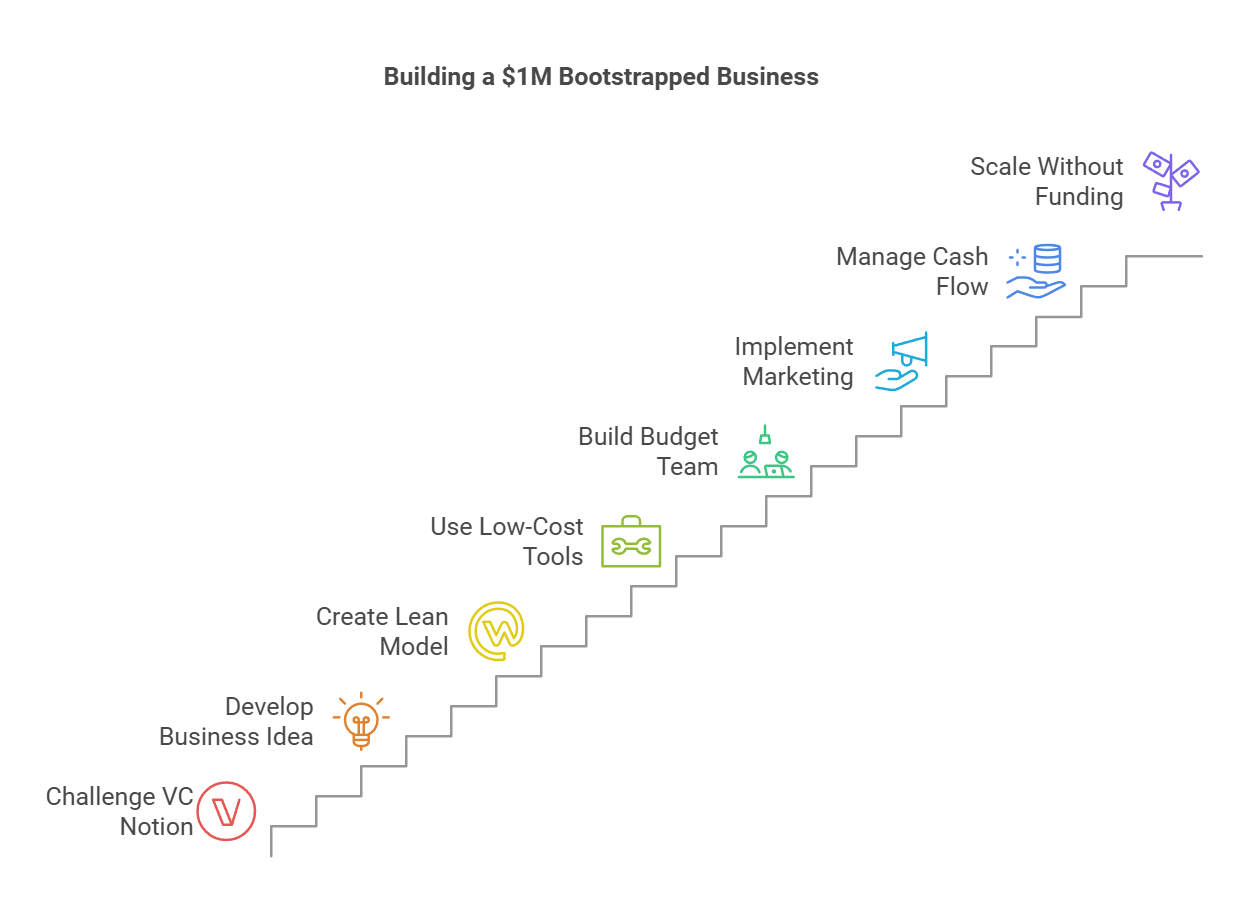
Advantages of Self-Funding
Now, you might be wondering, “Why would I choose to bootstrap when I could chase after investors?” Well, my friend, self-funding comes with a treasure trove of benefits:
- Complete control over your business decisions
- No pressure to satisfy external stakeholders
- The ability to pivot quickly without seeking approval
- A deeper sense of accomplishment and ownership
When you bootstrap, every win is yours to celebrate, and every lesson learned is a personal growth opportunity. It’s like being the captain of your own ship, charting your course through the entrepreneurial seas.
Common Misconceptions About Venture Capital
Let’s bust some myths, shall we? Many aspiring entrepreneurs believe that venture capital is the golden ticket to success. But here’s the truth: VC funding isn’t always the pot of gold at the end of the rainbow. It often comes with strings attached, diluted ownership, and pressure to grow at an unsustainable pace.
Remember, for every VC success story you hear, there are countless others who’ve built thriving businesses without a dime of outside investment. So, let’s roll up our sleeves and explore how you can join their ranks!
Developing a Viable Business Idea
The foundation of any successful business is a rock-solid idea. But how do you come up with one that’s not only brilliant but also bootstrappable?
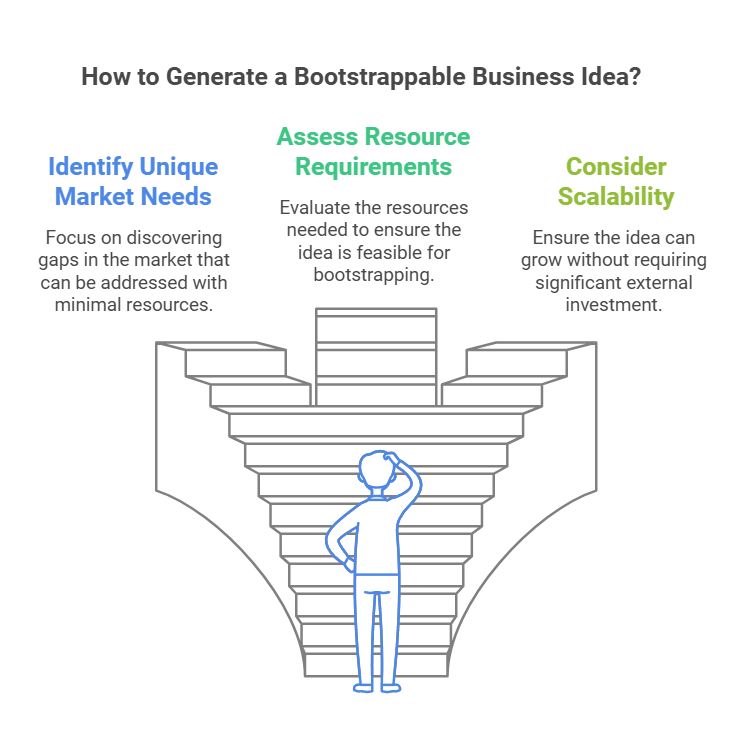
Identifying Market Gaps
Start by looking for problems that need solving or needs that aren’t being met in the market. Your million-dollar idea could be hiding in plain sight! Ask yourself:
- What frustrates you in your daily life?
- What services or products do you wish existed?
- What inefficiencies do you see in your industry?
Remember, some of the most successful businesses started by solving simple, everyday problems. Think about how Airbnb transformed the way we travel, all because its founders couldn’t afford their rent!
Validating Your Concept
Before you dive headfirst into building your business, it’s crucial to validate your idea. This doesn’t have to be an expensive or time-consuming process. Here are some low-cost ways to test the waters:
- Create a landing page to gauge interest
- Conduct surveys or interviews with potential customers
- Build a minimum viable product (MVP) and get feedback
- Use crowdfunding platforms to assess demand
By validating your concept early on, you’ll save yourself time, money, and heartache down the road. Plus, you’ll gain valuable insights that’ll help you refine your offering.
Creating a Lean Business Model
Now that you’ve got a validated idea, it’s time to build a business model that’s leaner than a marathon runner. When you’re bootstrapping, every penny counts, so we need to get creative with how we structure our operations.
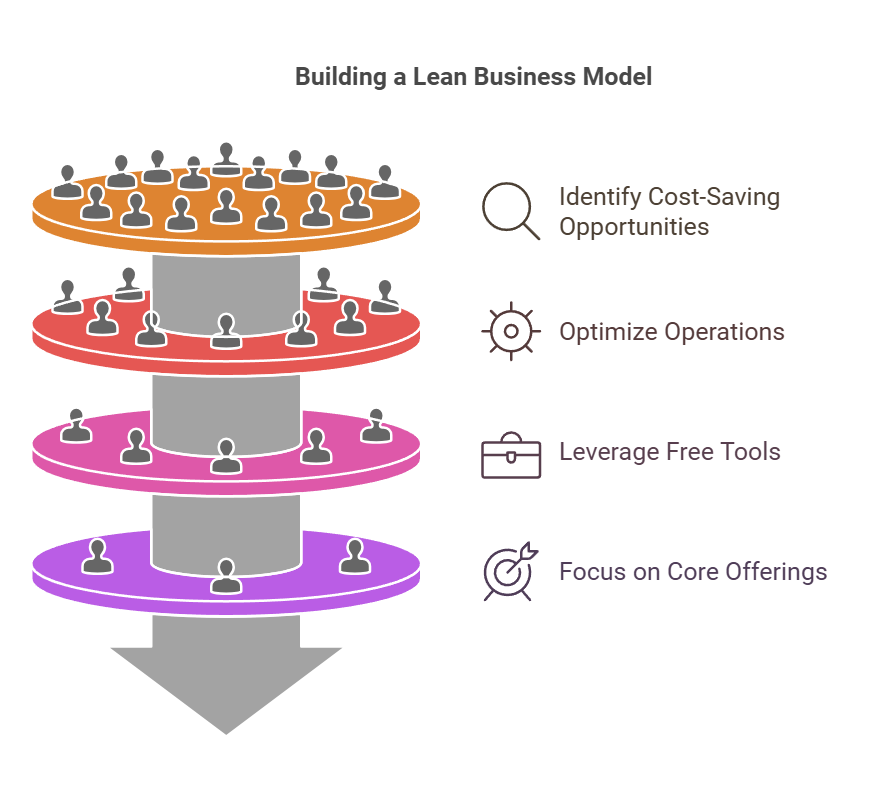
Minimizing Overhead Costs
The key to a successful bootstrapped business is keeping your costs low, especially in the early stages. Here are some ways to slash those overhead expenses:
- Work from home or use co-working spaces instead of renting an office
- Utilize virtual assistants instead of hiring full-time employees
- Opt for cloud-based services rather than expensive hardware
- Barter services with other businesses to reduce cash outlay
Remember, every dollar you save on overhead is a dollar you can reinvest in growing your business. Think of yourself as a financial ninja, always on the lookout for ways to cut costs without sacrificing quality.
Focusing on Core Offerings
When you’re bootstrapping, it’s tempting to try and be everything to everyone. But trust me, that’s a recipe for disaster. Instead, focus on doing one thing exceptionally well. This approach allows you to:
- Streamline your operations
- Build a strong brand identity
- Become known as an expert in your niche
- Allocate resources more effectively
As you grow, you can always expand your offerings. But in the beginning, it’s all about nailing that core product or service that’ll put you on the map.
Leveraging Free and Low-Cost Tools
One of the beautiful things about starting a business today is the abundance of free and low-cost tools at our fingertips. Let’s explore how you can harness these resources to build your empire on a shoestring budget.
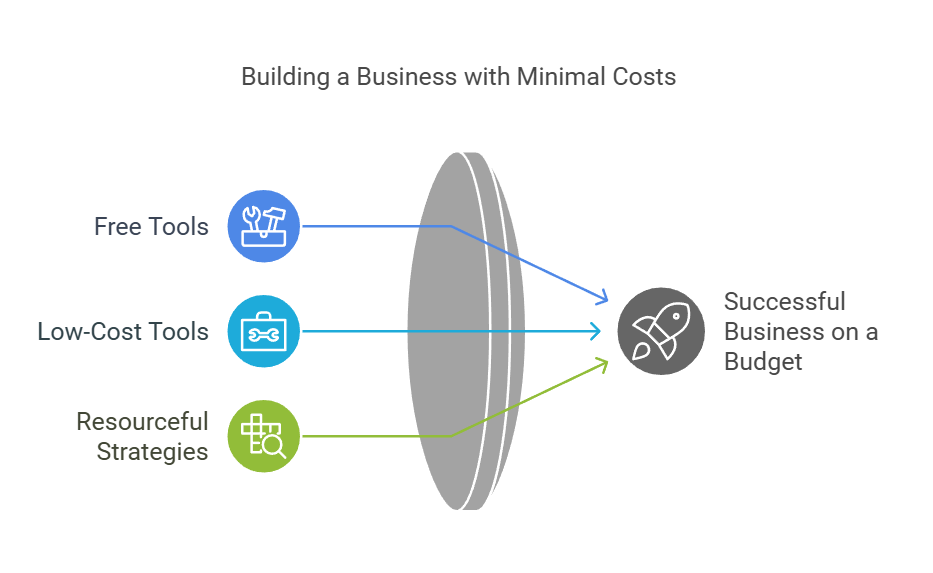
Essential Software for Startups
You don’t need to break the bank on fancy software to run a professional operation. Here’s a list of some fantastic tools that’ll help you get started:
- Mailchimp for email marketing
- Hootsuite or Buffer for social media management
- Trello or Asana for project management
- Canva for graphic design
- Google Workspace for email, documents, and collaboration
- Wave or QuickBooks for accounting
These tools can help you streamline your operations, boost productivity, and present a polished image to your customers — all without draining your bank account.
Maximizing Social Media Platforms
Social media isn’t just for sharing cat videos (although we all love those). It’s a powerful, free marketing tool that can help you reach millions of potential customers. Here’s how to make the most of it:
- Choose platforms that align with your target audience
- Create valuable, shareable content consistently
- Engage with your followers and build a community
- Use hashtags strategically to increase visibility
- Leverage user-generated content to build trust
Remember, social media success doesn’t happen overnight. It’s about building relationships and providing value over time. So, be patient, be authentic, and watch your online presence grow!
Building a Strong Team on a Budget
As your business grows, you’ll need to bring in talent to help you scale. But how do you build a dream team when you’re watching every penny? Let’s dive in.
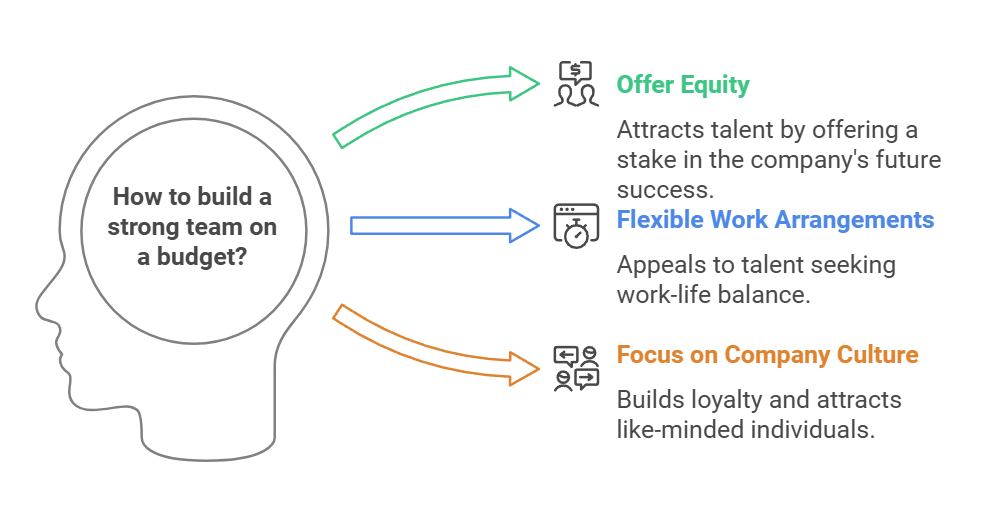
Hiring Strategies for Bootstrapped Startups
When it comes to hiring, think outside the box. Here are some strategies to consider:
- Hire part-time or contract workers instead of full-time employees
- Offer equity or profit-sharing to attract top talent
- Look for passionate individuals who are willing to learn and grow with the company
- Utilize freelance platforms like Upwork or Fiverr for specific projects
- Consider remote workers to expand your talent pool and reduce overhead
Remember, in a bootstrapped startup, cultural fit and passion are often more important than a fancy resume. Look for people who share your vision and are excited to roll up their sleeves and get things done.
Cultivating a Culture of Ownership
When you’re working with a lean team, it’s crucial to foster a sense of ownership among your employees. Here’s how:
- Involve team members in decision-making processes
- Encourage innovation and creative problem-solving
- Celebrate wins together, no matter how small
- Be transparent about the company’s goals and challenges
- Provide opportunities for professional growth and development
By creating a culture where everyone feels invested in the company’s success, you’ll build a team that’s motivated to go above and beyond — even without the lure of big corporate perks.
Implementing Effective Marketing Strategies
Marketing can make or break your business, but it doesn’t have to break the bank. Let’s explore some cost-effective ways to get your brand out there and attract customers.
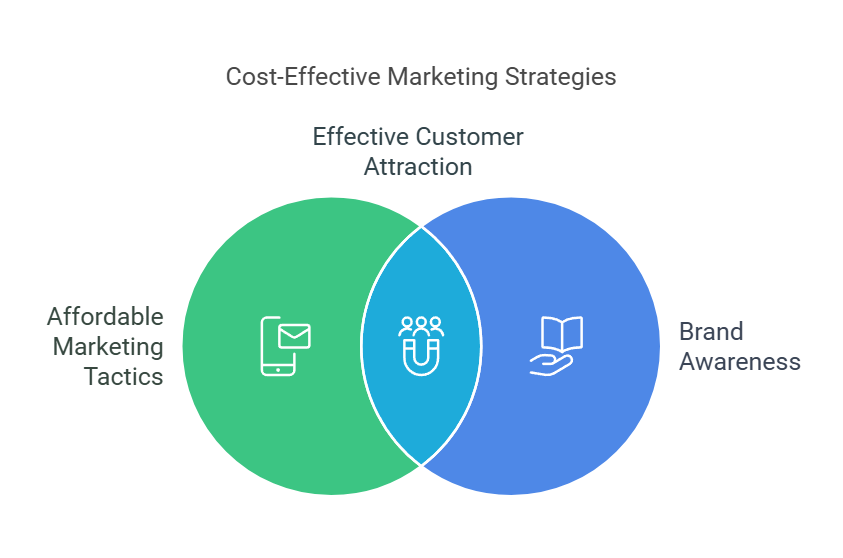
Content Marketing and SEO
Content is king, and it’s also one of the most affordable ways to market your business. Here’s how to leverage content marketing and SEO:
- Start a blog and consistently publish valuable content
- Optimize your website for search engines
- Create how-to guides, eBooks, or whitepapers to establish authority
- Guest post on relevant industry blogs
- Develop a strong keyword strategy
Remember, good SEO takes time, but it’s worth the effort. By creating high-quality, relevant content, you’ll not only improve your search rankings but also build trust with your audience.
Guerrilla Marketing Tactics
Sometimes, the most effective marketing strategies are the ones that think outside the box. Guerrilla marketing is all about using creativity and unconventional methods to promote your business. Here are some ideas:
- Create viral social media challenges
- Organize flash mobs or street performances
- Use stickers or chalk art to spread your message
- Partner with local businesses for cross-promotion
- Develop an eye-catching mascot or brand character
The key to guerrilla marketing is to be bold, memorable, and aligned with your brand values. Don’t be afraid to take calculated risks — sometimes, the craziest ideas are the ones that get people talking!
Managing Cash Flow Efficiently
Cash is the lifeblood of any business, but it’s especially crucial when you’re bootstrapping. Let’s talk about how to keep that cash flowing smoothly.
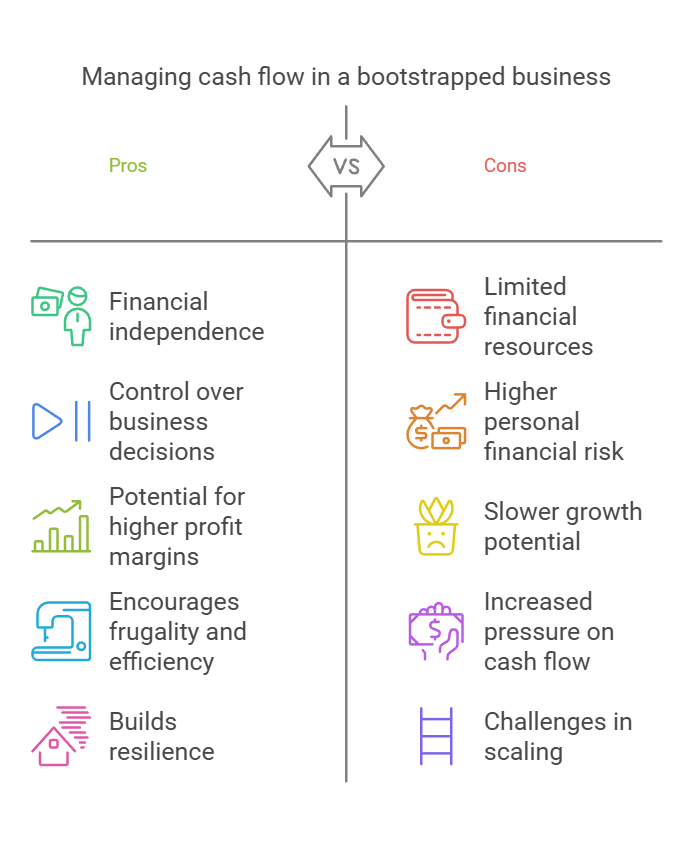
Strategies for Sustainable Growth
Growing too fast can be just as dangerous as not growing at all. Here are some strategies for sustainable growth:
- Focus on customer retention as much as acquisition
- Implement a robust invoicing and follow-up system
- Negotiate favorable payment terms with suppliers
- Consider offering subscriptions or recurring services for steady income
- Keep a close eye on your burn rate and adjust as needed
Remember, sustainable growth is about finding the right balance between expansion and financial stability. Don’t be afraid to pump the brakes if you feel like you’re growing too quickly for your resources to handle.
Reinvesting Profits Wisely
When you start seeing profits, it’s tempting to splurge or pay yourself a big bonus. But reinvesting those profits strategically can fuel your growth and get you to that $1M mark faster. Consider reinvesting in:
- Marketing and customer acquisition
- Product development or service expansion
- Technology upgrades
- Employee training and development
- Building a cash reserve for future opportunities or challenges
Think of your profits as seeds — plant them wisely, and they’ll grow into a thriving business forest!
Scaling Your Business Without External Funding
As your business gains traction, you’ll face the exciting challenge of scaling up. But how do you do that without outside investment? Let’s explore.
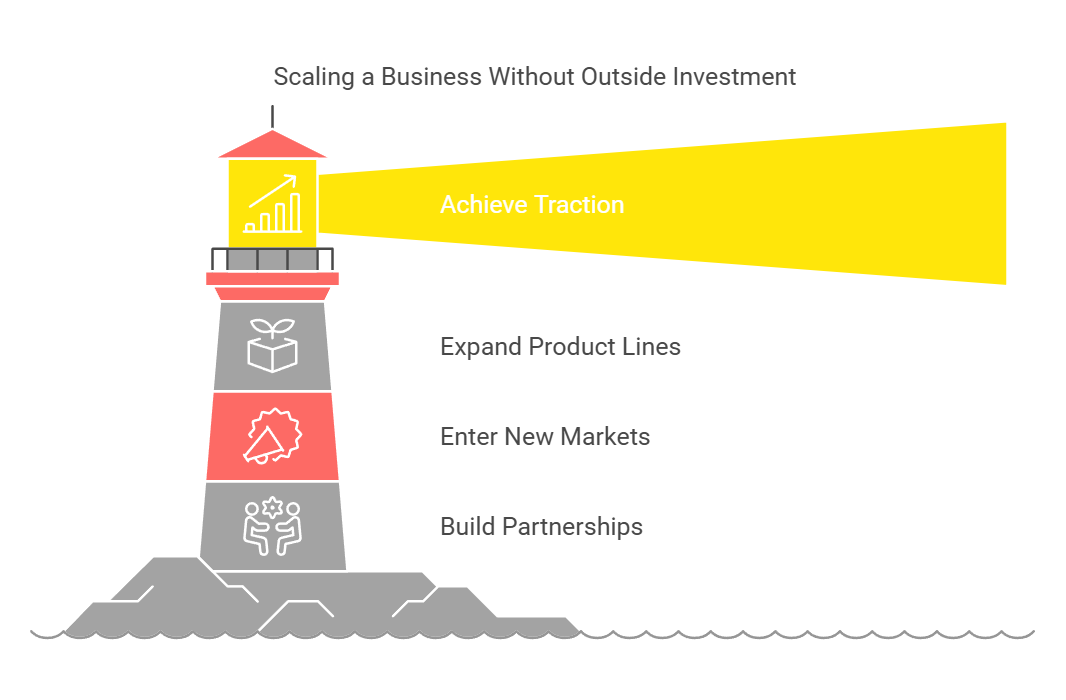
Expanding Product Lines or Services
One way to scale is by expanding what you offer. Here’s how to do it smartly:
- Listen to customer feedback for new product or service ideas
- Start with small, low-risk expansions to test the waters
- Use pre-orders or crowdfunding to gauge interest and fund development
- Look for complementary offerings that align with your core business
- Consider white-labeling or licensing to expand quickly with minimal investment
Remember, expansion should always serve your core business and target audience. Don’t stray too far from what made you successful in the first place.
Entering New Markets
Another scaling strategy is to take your existing offerings to new markets. This could mean:
- Expanding to new geographic locations
- Targeting different customer segments
- Adapting your product for different industries
- Exploring international markets
When entering new markets, do your homework. Research thoroughly, start small, and be prepared to adapt your approach based on local needs and preferences.
Building Strategic Partnerships
In the world of bootstrapping, you don’t have to go it alone. Strategic partnerships can help you grow faster and more efficiently than you could on your own.
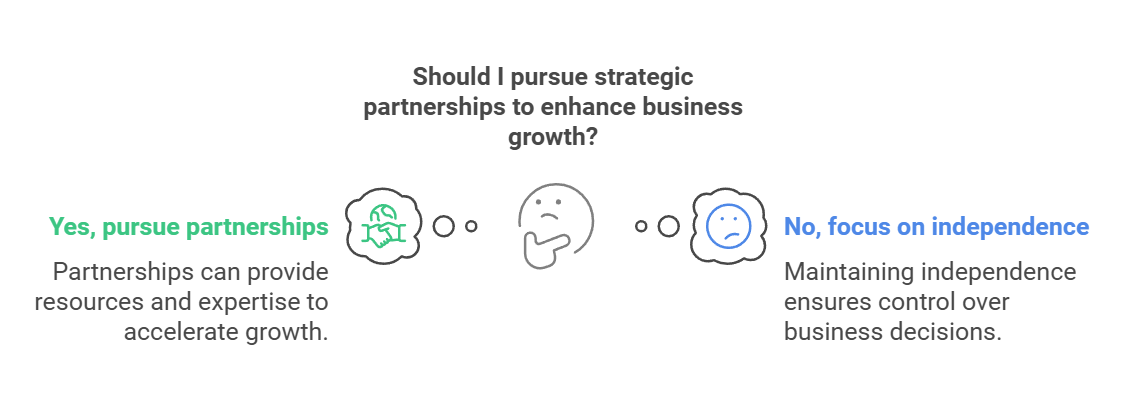
Identifying Complementary Businesses
Look for businesses that complement yours — not direct competitors, but companies that serve a similar audience or provide services that enhance your offerings. For example:
- If you run a fitness app, partner with health food brands or workout equipment manufacturers
- If you offer web design services, team up with copywriters or SEO specialists
- If you sell handmade jewelry, collaborate with fashion bloggers or boutique clothing stores
The key is to find partners whose strengths complement your weaknesses, and vice versa.
Negotiating Win-Win Collaborations
When approaching potential partners, focus on creating mutually beneficial arrangements. This could include:
- Cross-promotion on social media or email lists
- Co-creating products or services
- Bundling offerings for special promotions
- Sharing resources like office space or equipment
- Referring clients to each other
Remember, the best partnerships are built on trust, clear communication, and shared goals. Take the time to develop strong relationships, and you’ll reap the rewards in the long run.
Overcoming Common Challenges in Bootstrapping
Let’s face it — bootstrapping isn’t always a walk in the park. But with the right mindset and strategies, you can overcome the hurdles that come your way.

Dealing with Limited Resources
When resources are tight, creativity becomes your superpower. Here’s how to make the most of what you have:
- Prioritize ruthlessly — focus on what truly moves the needle
- Learn to wear multiple hats and develop new skills
- Leverage your network for advice, introductions, and support
- Look for creative ways to barter or trade services
- Stay lean and agile, ready to pivot when necessary
Remember, constraints can breed innovation. Some of the most groundbreaking ideas have come from entrepreneurs who had to think creatively due to limited resources.
Maintaining Work-Life Balance
Bootstrapping often means long hours and high stress. But burning out won’t do you or your business any favors. Here are some tips to maintain balance:
- Set clear boundaries between work and personal time
- Practice self-care — exercise, eat well, and get enough sleep
- Delegate tasks and learn to trust your team
- Take regular breaks to recharge and gain perspective
- Celebrate small wins along the way
Remember, building a successful business is a marathon, not a sprint. Pace yourself and take care of your most valuable asset — you!
Case Studies — Successful Bootstrapped Businesses
Let’s draw inspiration from those who’ve walked this path before us. Here are a couple of examples of businesses that bootstrapped their way to success:
- Mailchimp: Started as a side project, Mailchimp grew into a billion-dollar email marketing platform without any external funding.
- GitHub: Before its $7.5 billion acquisition by Microsoft, GitHub bootstrapped its way to success, focusing on building a product developers loved.
Lessons from Real-World Examples
What can we learn from these success stories?
- Focus on solving a real problem for your customers
- Be patient — success often takes years, not months
- Reinvest profits to fuel growth
- Build a strong company culture
- Stay close to your customers and adapt to their needs
These bootstrapped successes prove that with the right idea, execution, and perseverance, you can build a thriving business without outside investment.
Conclusion — Your Path to a $1M Bootstrapped Business
We’ve covered a lot of ground, from developing your idea to scaling your business and overcoming challenges. As we wrap up this entrepreneurial journey, let’s recap the key takeaways that will set you on the path to building your own $1M bootstrapped business:
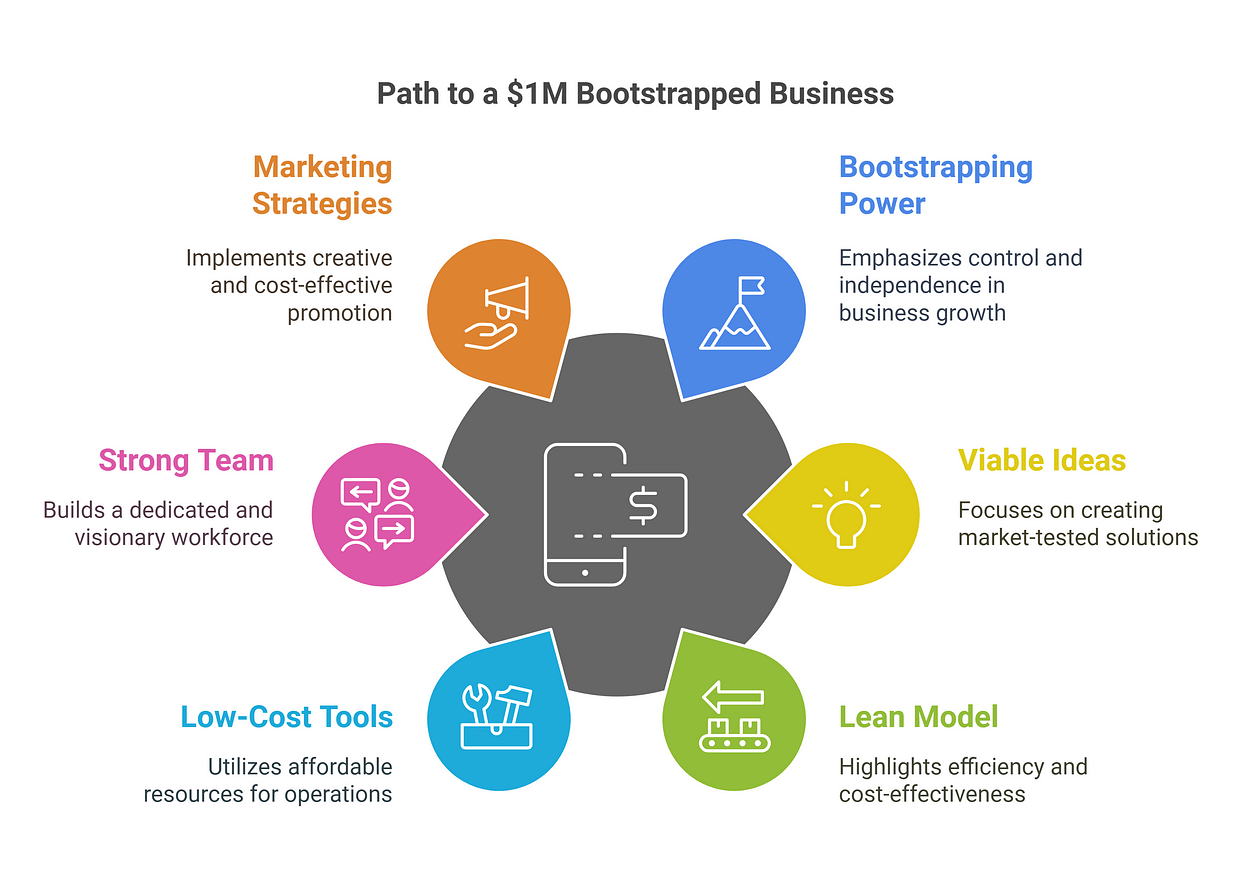
- Embrace the power of bootstrapping and the control it gives you over your business destiny.
- Develop a viable, market-tested idea that solves real problems for your customers.
- Create a lean business model that minimizes costs and maximizes efficiency.
- Leverage free and low-cost tools to run your operations like a pro without breaking the bank.
- Build a strong, passionate team that shares your vision and drive.
- Implement cost-effective marketing strategies that focus on content, SEO, and creative guerrilla tactics.
- Manage your cash flow wisely and reinvest profits strategically for sustainable growth.
- Scale your business through product expansion and entering new markets, all while staying true to your core offerings.
- Build strategic partnerships that complement your strengths and open new opportunities.
- Overcome common bootstrapping challenges with creativity, resilience, and a balanced approach to work and life.
Remember, building a $1M business without outside investment is not just possible — it’s been done time and time again by entrepreneurs just like you. It requires dedication, smart decision-making, and a willingness to learn and adapt along the way. But the rewards — both financial and personal — can be truly life-changing.
Your bootstrapping journey, keep in mind that every successful business started with a single step. Your million-dollar idea is waiting to be brought to life, and now you have the roadmap to make it happen. So, what are you waiting for? It’s time to roll up your sleeves, put these strategies into action, and start building your dream business — no investors required!
Frequently Asked Questions
1. How long does it typically take to build a $1M business through bootstrapping?
There’s no one-size-fits-all answer, as it depends on factors like your industry, business model, and market conditions. Some businesses reach the $1M mark in a few years, while others may take 5–10 years. The key is to focus on sustainable growth rather than rushing to hit a specific number.
2. Is it possible to bootstrap in industries that traditionally require high initial investment?
Yes, it’s possible, but it may require more creativity and a different approach. Consider starting with a smaller scale operation, using rental or shared equipment, or offering services before moving into product manufacturing. Many successful businesses in capital-intensive industries have started small and scaled up over time.
3. How do I know when it’s time to seek outside investment, if ever?
Consider seeking investment if you’ve hit a growth ceiling that you can’t break through with your current resources, or if there’s a time-sensitive market opportunity that requires rapid scaling. However, make sure you’ve exhausted all bootstrapping options first and that you’re in a strong position to negotiate with potential investors.
4. What’s the biggest mistake bootstrappers make when trying to reach $1M in revenue?
One common mistake is trying to grow too quickly without a solid foundation. This can lead to cash flow problems, quality issues, or burnout. Focus on building a sustainable business with strong fundamentals before pushing for rapid growth.
5. How important is networking when bootstrapping a business?
Networking is crucial for bootstrapped businesses. It can lead to partnerships, client referrals, mentorship opportunities, and valuable advice — all without spending money.
Attend industry events, join professional groups, and don’t be afraid to reach out to people you admire in your field. Building a strong network can be one of your most valuable assets as a bootstrapped entrepreneur.
Disclaimer: The opinions/views expressed in this article exclusively represent the individual perspectives of the author. While we affirm the value of diverse viewpoints and advocate for the freedom of individual expression, we do not endorse derogatory or offensive comments against any caste, creed, race, or similar distinctions. For any concerns or further information, we invite you to contact us at academy@enago.com
- By clicking here, I state that I have read and understood the terms and conditions mentioned above.









